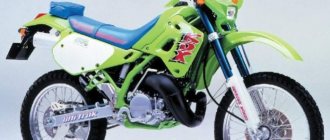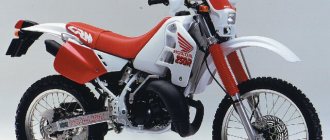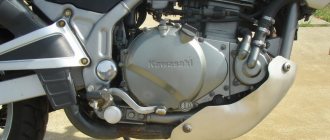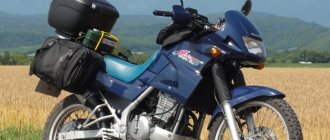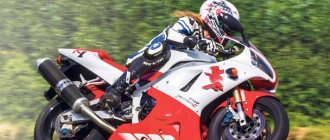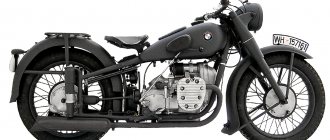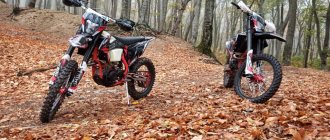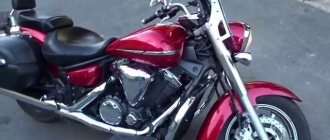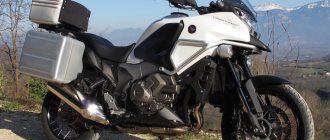| Kawasaki KDX250 (KDX250A) 1980 | Kawasaki KDX250 (KDX250B) 1981-1984 | Kawasaki KDX250 / KDX250R (KDX250E / KDX250D) 1991-1995 | Kawasaki KDX250SR (KDX250F) 1991-1994 |
Kawasaki KDX250 enduro model
begins its history in 1980, when the first generation of a motorcycle was introduced to the market, which was available only in the USA.
That generation was, by today's standards, quite archaic - 2-stroke air-cooled engine, drum brakes and crude plastics. Factory model code is KDX250-A
.
In 1981, the Kawasaki KDX250 underwent minor changes, receiving turn signals and a new plastic design. Factory model code - KDX250-B
. 1984 was the last year of production.
In 1991, Kawasaki resumed production of the KDX250, seriously updating it both externally and technically - a new liquid-cooled engine, disc brakes, and an inverted fork. Starting this year, the model became available not only in the North American market, but also in Europe, Australia and Japan. Now 3 modifications of the motorcycle were offered:
- Kawasaki KDX250R
(KDX250-D) - “hard enduro” modification. It does not have turn signals or a speedometer (it is equipped with a simple trip meter with daily and total mileage). Was available from 1991 to 1995. in Europe, North America and Japan. - Kawasaki KDX250
(KDX250-E) - identical to the previous modification, but with the possibility of use on special stages. Equipped with turn signals and a full speedometer. Existed from 1991 to 1992. in the markets of Europe and Australia. - Kawasaki KDX250SR
(KDX250-F) - “soft-enduro” modification. Was available from 1991 to 1994. only in the Japanese domestic market. It is a previous modification with a number of changes: the presence of mirrors, other suspension and geometry settings, a smaller fuel tank (from 12.5 to 11.0 l), a smaller carburetor (PWK35 instead of PWK38), other gearbox settings, dry weight increased by 9 kg .
1995 was the last year of production of the Kawasaki KDX 250, after which it finally left the market and did not receive further development.
The main competitors of the Kawasaki KDX 250 in the class:
- Honda CRM 250
- Suzuku RMX 250 S
Appearance
The Kawasaki KDX 250 looks like a typical enduro. Colors vary, but the color usually appears is green. The light green bike with a blue seat and shock absorbers looks especially impressive. The front light is small and square, like enduro and supermoto.
Spoke wheels make the bike lighter. The front wheel is slightly larger than the rear. The details are clearly visible, which gives the bike a unique effect. However, the frame covers a significant part. There are many similarities between the appearance of the KDX 250 and motocross bikes.
Comfort
The motorcycle is convenient primarily for those who like to travel to places with not very good roads or without them. A tourist or, especially, a sports-tourist option is not suitable here. And enduro copes well with mud and other difficulties of wild places.
Of course, you won’t be able to take anything with you other than a backpack. But with a competent approach to motorcycle tourism, nothing else is needed. It is important that you have at least two GPS navigators with you, and that the route is thoroughly thought out. Otherwise, the bike is convenient, including maintenance and searching for spare parts.
Dimensions and weight
In terms of dimensions, this bike meets class standards. Weight, ground clearance, wheelbase - all this makes the motorcycle excellently passable and controllable in wild and difficult conditions. But we can’t say that this is a special advantage of a particular model, because most other enduros have the same dimensions.
Dimensions and weight are:
- height – 1250 mm;
- width – 850 mm;
- length – 2165 mm;
- wheelbase – 1475 mm;
- seat height – 955 mm;
- ground clearance - 340 mm;
- curb weight – 116 kg;
- Tank capacity – 12.5 l.
The fuel tank capacity will last a long time, although it is small. So it is important to make sure that you come across gas stations on time along the route, because there will be no other opportunity to refuel the tank on such a trip.
Specifications
According to these parameters, the bike is not inferior to many others, although it is not advanced. It is important to remember the time when it was produced and make allowances when comparing with current enduro representatives. However, even today, in terms of technical characteristics, the car remains competitive with weak current models.
| Motor type | in-line, 1 cylinder, 2 stroke |
| Power | 40 hp |
| Torque | 40.2 Nm |
| Maximum speed | 180 km/h |
| Acceleration to 100 | 7.1 s |
| Fuel consumption per hundred | 7 l |
| Drive unit | chain |
| Transmission | five-speed |
| Frame | half-duplex steel |
| Rear suspension | pendulum, monoshock absorber, stroke 310 mm |
| Front suspension | inverted fork, 300 mm travel |
| Rear brakes | 1 disc, 190 mm, 1-piston caliper |
| Front brakes | 1 disc, 220 mm, 2-piston caliper |
Such parameters make this bike suitable for those who want to try off-road riding, but are wary of some powerful motocross bike. Also, connoisseurs of old representatives of the class will appreciate how the car is made and the path it has traveled.
Kawasaki KDX 250 - a distinctive enduro from the last century
This is a distinctive enduro from the last century. The Kawasaki KDX 250 is a vehicle for serious riding in wild and not so wild places, capable of covering long distances.
This applies to the entire enduro class, in which this Kawasaki motorcycle, although not the best, occupies a prominent place.
Appearance
The Kawasaki KDX 250 looks like a typical enduro. Colors vary, but the color usually appears is green. The light green bike with a blue seat and shock absorbers looks especially impressive. The front light is small and square, like enduro and supermoto.
Spoke wheels make the bike lighter. The front wheel is slightly larger than the rear. The details are clearly visible, which gives the bike a unique effect. However, the frame covers a significant part. There are many similarities between the appearance of the KDX 250 and motocross bikes.
Comfort
The motorcycle is convenient primarily for those who like to travel to places with not very good roads or without them. A tourist or, especially, a sports-tourist option is not suitable here. And enduro copes well with mud and other difficulties of wild places.
Of course, you won’t be able to take anything with you other than a backpack. But with a competent approach to motorcycle tourism, nothing else is needed. It is important that you have at least two GPS navigators with you, and that the route is thoroughly thought out. Otherwise, the bike is convenient, including maintenance and searching for spare parts.
Dimensions and weight
In terms of dimensions, this bike meets class standards. Weight, ground clearance, wheelbase - all this makes the motorcycle excellently passable and controllable in wild and difficult conditions. But we can’t say that this is a special advantage of a particular model, because most other enduros have the same dimensions.
Dimensions and weight are:
- height – 1250 mm;
- width – 850 mm;
- length – 2165 mm;
- wheelbase – 1475 mm;
- seat height – 955 mm;
- ground clearance - 340 mm;
- curb weight – 116 kg;
- Tank capacity – 12.5 l.
The fuel tank capacity will last a long time, although it is small. So it is important to make sure that you come across gas stations on time along the route, because there will be no other opportunity to refuel the tank on such a trip.
Specifications
According to these parameters, the bike is not inferior to many others, although it is not advanced. It is important to remember the time when it was produced and make allowances when comparing with current enduro representatives. However, even today, in terms of technical characteristics, the car remains competitive with weak current models.
| Motor type | in-line, 1 cylinder, 2 stroke |
| Power | 40 hp |
| Torque | 40.2 Nm |
| Maximum speed | 180 km/h |
| Acceleration to 100 | 7.1 s |
| Fuel consumption per hundred | 7 l |
| Drive unit | chain |
| Transmission | five-speed |
| Frame | half-duplex steel |
| Rear suspension | pendulum, monoshock absorber, stroke 310 mm |
| Front suspension | inverted fork, 300 mm travel |
| Rear brakes | 1 disc, 190 mm, 1-piston caliper |
| Front brakes | 1 disc, 220 mm, 2-piston caliper |
Such parameters make this bike suitable for those who want to try off-road riding, but are wary of some powerful motocross bike. Also, connoisseurs of old representatives of the class will appreciate how the car is made and the path it has traveled.
Production
Production began back in 1980. Then, of course, it was a car that was interesting to many. The technical parameters of this motorcycle at that time were very good.
The production lasted a long time and ended only in 1995. Of course, this is not the most striking example of longevity on the assembly line, but still, fifteen years of history is a considerable period.
Classmates
Perhaps the main competitor of the model is the RMX 250 S from Suzuki. However, the CRM 250 from Honda also competes.
Both bikes more or less correspond to Kawasaki in terms of technical parameters, and it is impossible to say which machine is definitely worse and which is better.
History of changes
There have been few changes, but this is good, because it speaks about the quality of the bike. This means that the equipment was originally designed in such a way that almost nothing had to be modified. Those changes that have been made are more likely to be cosmetic. However, these are also important to note.
Here's the evolution of the Kawasaki KDX 250:
- In 1981 there was a restyling. Since then, the model is already considered the second generation.
- In 1991, the third generation saw the light. There was a new restyling, and a couple of modifications arose.
- In 1995, the last year of production, all modifications were no longer offered.
The fact that production stopped is natural given the development of technology. Updating an enduro, sport bike or even road motorcycles to a modern, up-to-date state is not easy, because it is much cheaper and more expedient to release a new motorcycle from scratch that keeps up with modern times.
What do the owners say?
The motorcycle is reliable, which is clear from the photos and videos. Most owners agree with this. However, someone notes that among all the enduros he has tried, this is not the most reliable.
According to the descriptions of those who have been traveling this way for a long time, the bike usually does not fail, but they still do not advise traveling far from civilization.
Judging by the reviews, it is possible to get good used equipment, but it is important to carefully read the documents. It is advisable to apply all modern methods of checking the condition of the bike to make sure that the machine is well preserved. If the equipment looks good on the outside, this does not mean anything.
Also, one review or another notes that this motorcycle is easy to buy. About 100 thousand Russian rubles – that’s how much such a model costs. The car is praised for its handling and ease of use, but few people called this option the best in the enduro class.
In conclusion, the Kawasaki KDX 250 is the choice for those who want to travel alone and without luggage. The bike is reliable and comfortable, although the best results at the end of the twentieth century were, of course, achieved by Honda. In any case, the machine from Kawasaki is not bad and is still capable of competing with current models.
History of changes
There have been few changes, but this is good, because it speaks about the quality of the bike. This means that the equipment was originally designed in such a way that almost nothing had to be modified. Those changes that have been made are more likely to be cosmetic. However, these are also important to note.
Here's the evolution of the Kawasaki KDX 250:
- In 1981 there was a restyling. Since then, the model is already considered the second generation.
- In 1991, the third generation saw the light. There was a new restyling, and a couple of modifications arose.
- In 1995, the last year of production, all modifications were no longer offered.
The fact that production stopped is natural given the development of technology. Updating an enduro, sport bike or even road motorcycles to a modern, up-to-date state is not easy, because it is much cheaper and more expedient to release a new motorcycle from scratch that keeps up with modern times.
Review of the Kawasaki KDX250 motorcycle (KDX250R, KDX250SR)
Kawasaki KDX250
enduro model dates back to 1980, when the first generation of the motorcycle, which was only available in the United States, was introduced to the market.
That generation, by today's standards, was quite archaic - 2-stroke air-cooled engine, drum brakes and crude plastics. Factory model code is KDX250-A
.
In 1981, the Kawasaki KDX250 underwent minor changes, receiving turn signals and a new plastic design. Factory model code – KDX250-B
. 1984 was the last year of production.
In 1991, Kawasaki resumed production of the KDX250, seriously updating it both externally and technically - a new liquid-cooled engine, disc brakes, and an inverted fork. Starting this year, the model became available not only in the North American market, but also in Europe, Australia and Japan. Now 3 modifications of the motorcycle were offered:
- Kawasaki KDX250R
(KDX250-D) – “hard enduro” modification. It does not have turn signals or a speedometer (it is equipped with a simple trip meter with daily and total mileage). Was available from 1991 to 1995. in Europe, North America and Japan. - Kawasaki KDX250
(KDX250-E) – identical to the previous modification, but with the possibility of use on special stages. Equipped with turn signals and a full speedometer. Existed from 1991 to 1992. in the markets of Europe and Australia. - Kawasaki KDX250SR
(KDX250-F) – “soft-enduro” modification. Was available from 1991 to 1994. only in the Japanese domestic market. It is a previous modification with a number of changes: the presence of mirrors, other suspension and geometry settings, a smaller fuel tank (from 12.5 to 11.0 l), a smaller carburetor (PWK35 instead of PWK38), other gearbox settings, dry weight increased by 9 kg .
1995 was the last year of production of the Kawasaki KDX 250, after which it finally left the market and did not receive further development.
The main competitors of the Kawasaki KDX 250 in the class:
Content
Brief history of the model
- 1980 – start of production and sales. First generation.
Model
: Kawasaki KDX250 (North America).
Factory designation:
KDX250-A1.
- 1981 – restyling of the model. Second generation.
Model
: Kawasaki KDX250 (North America).
Factory designation:
KDX250-B1.
- 1982 – no significant changes.
Model
: Kawasaki KDX250 (North America).
Factory designation:
KDX250-B2.
- 1983 – no significant changes.
Model
: Kawasaki KDX250 (North America).
Factory designation:
KDX250-B3.
- 1984 – no significant changes.
Model
: Kawasaki KDX250 (North America).
Factory designation:
KDX250-B4.
- 1991 – restyling of the model. Third generation
. The emergence of new modifications and expansion of sales markets.
Model
: Kawasaki KDX250;
Kawasaki KDX250R; Kawasaki KDX250SR (North America, Europe, Australia, Japan). Factory designation:
KDX250-E1; KDX250-D1; KDX250-F1.
What do the owners say?
The motorcycle is reliable, which is clear from the photos and videos. Most owners agree with this. However, someone notes that among all the enduros he has tried, this is not the most reliable.
According to the descriptions of those who have been traveling this way for a long time, the bike usually does not fail, but they still do not advise traveling far from civilization.
Judging by the reviews, it is possible to get good used equipment, but it is important to carefully read the documents. It is advisable to apply all modern methods of checking the condition of the bike to make sure that the machine is well preserved. If the equipment looks good on the outside, this does not mean anything.
Also, one review or another notes that this motorcycle is easy to buy. About 100 thousand Russian rubles – that’s how much such a model costs. The car is praised for its handling and ease of use, but few people called this option the best in the enduro class.
In conclusion, the Kawasaki KDX 250 is the choice for those who want to travel alone and without luggage. The bike is reliable and comfortable, although the best results at the end of the twentieth century were, of course, achieved by Honda. In any case, the machine from Kawasaki is not bad and is still capable of competing with current models.
Reviews
Reviews about Kawasaki KDX 250:
Expand Collapse
Normal device. I had an '89 KDX 200SR. Very smooth thrust for 2T, due to power valves at the exhaust. It's great at the top too! The frame and chassis are in principle indestructible; everything worked on the 1989 vehicle. “SR” is a domestic Japanese model; it is distinguished by the presence of a separate lubrication system, tidy, normal lighting and turn signals. So just what you need. It is possible both on shit roads and on public roads. I myself used it for “dacha racing”. Among the problem areas, these same power valves periodically become clogged with carbon deposits and stop working. In general, sometimes they require maintenance. Models after '94 are less susceptible to this problem. When purchasing, you should pay special attention to the piston! Because These bikes, as a rule, are far from new. And the boiler is made of aluminum with nikasil, which, although reliable, does not last forever. It cannot be repaired; in principle, you can buy a new boiler, but it costs as much as a cast-iron bridge! I don’t remember any other weak points...
